Meet Sydney’s most stylish couple
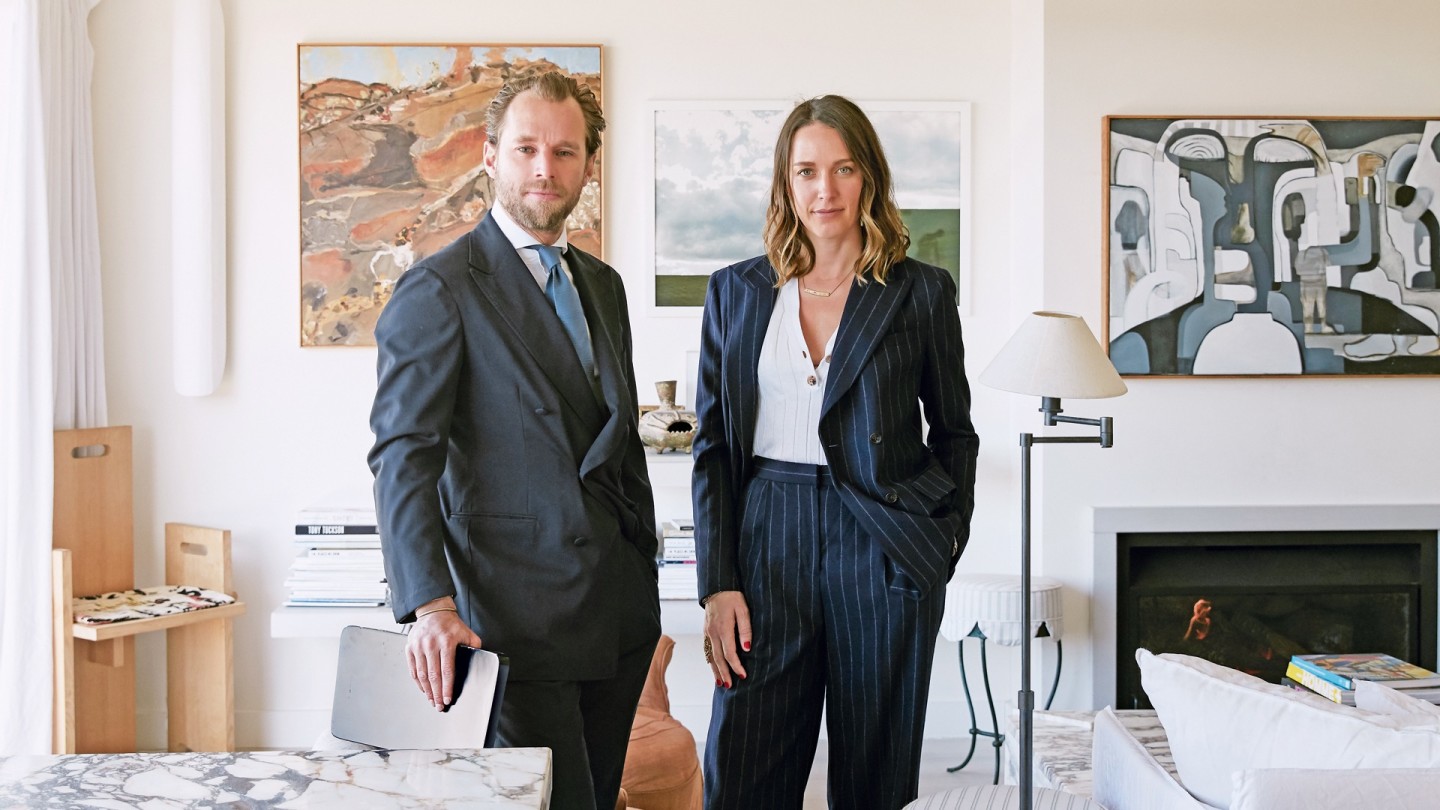
Roula Khalaf, Editor of the FT, selects her favourite stories in this weekly newsletter.
Tamarama Beach sits between two verdant headlands in the deep horseshoe curve of Mackenzies Bay, just south of Bondi. It is one of Sydney’s smaller beaches, but it packs real Australian punch into its 80 or so metres of fine white sand. There are tall, curling breaks that reliably draw enfilades of surfers most mornings; there is a stretch of the city’s famous Bondi-to-Coogee walk hugging its perimeter; and in November of each year, there is Sculptures by the Sea, a free-to-the-public art installation – one of the world’s largest – conferring a bit of cultural bona fides to this most easy-breezy set of coordinates.
Just above the beach, in a four-bedroom bungalow whose terrace overlooks Tamarama’s foaming aquamarine breaks, live Patrick and Tamsin Johnson. He’s an Adelaide boy who produces made-to-measure menswear and accessories; she, born and raised in Melbourne, is a sought-after interior designer. Today they are two of Sydney’s heaviest creative-hitters, and one of its most high-profile couples. Patrick has ateliers in Sydney’s Paddington and Melbourne, both of whose interiors Tamsin designed; their personal art collection rotates in and out of the showrooms from the bungalow, where they live with Arthur, three, and 18-month-old Bunny. The Johnsons are friendly and easygoing and good-looking, and just nice – in short, quintessential Australians, as much of the rest of the world imagines Australians to be.
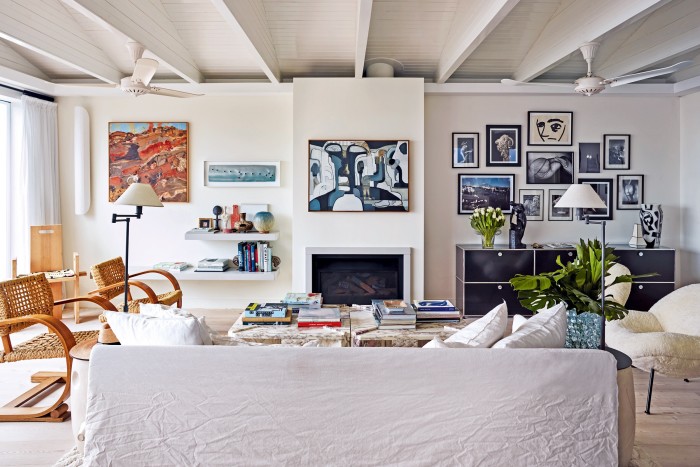
And the world imagines Australia a lot. If it is by now so widely acknowledged as to be axiomatic that the once‑ineffable concept of “lifestyle” has been totally commodified by social media, then Australia – in particular, Sydney – has to be one of its most exportable permutations. The flip-flops and firm bodies; the frothy resort fashions and microscopic swimwear; the rosé chilling by the rock pool; the avocado toast. It’s a place that is almost absurdly picturesque, with a disproportionately large contingent of lissom, healthy-living, eminently photogenic citizens in its population. No wonder it’s such a powerful manifestation of #thedream.
But what makes the Johnsons interesting is not what’s quintessentially Australian about them, but instead how far away from Australia their respective creative formations took place – culturally as well as geographically. Tamsin spent her childhood summers trailing her father, the antiques dealer Ed Clarke, around the fairs and marchés of southern France. “I grew up watching shipping containers being emptied into our garage,” she says. “Dad bought, Mum sold. Antiques and provenance were what I knew. We had a Louis XV settee at home and it was unbelievably uncomfortable – I used to love going to my girlfriends’ houses and just sinking into their Poliform or Minotti or whatever sofas. But that kind of exposure from such a young age was incredible. I learnt about what was good without even consciously knowing it.” She moved to London in her 20s to pursue a degree at the Inchbald School of Design, then spent four years at the now-disbanded Sydney firm Meacham Nockles McQualter, where she worked on designs for Bill Granger’s restaurants and Zimmermann boutiques (both of which had achieved international renown, and were proliferating around the world) before leaving to start her own business in 2013. After studying oenology in Adelaide, Patrick also made his way to London, where he learnt the tailoring trade from the ground up, apprenticing for six years at Robert Emmett on Jermyn Street, with frequent research trips around Italy, where he now owns a factory outside Carrara that produces for the business he launched in 2009.
That shared cultural hinterland, deeply rooted in European and British tenets of craftsmanship and tradition, has informed everything the Johnsons do, together and individually. When they moved home, and that formation was filtered through all the received ideas of Australian style, what resulted was an aesthetic – a lifestyle, in fact – that’s a singular hybrid of Old and New World: layered, natural, at once deeply sophisticated and entirely at ease with itself. Pedigreed, but with sandy feet.
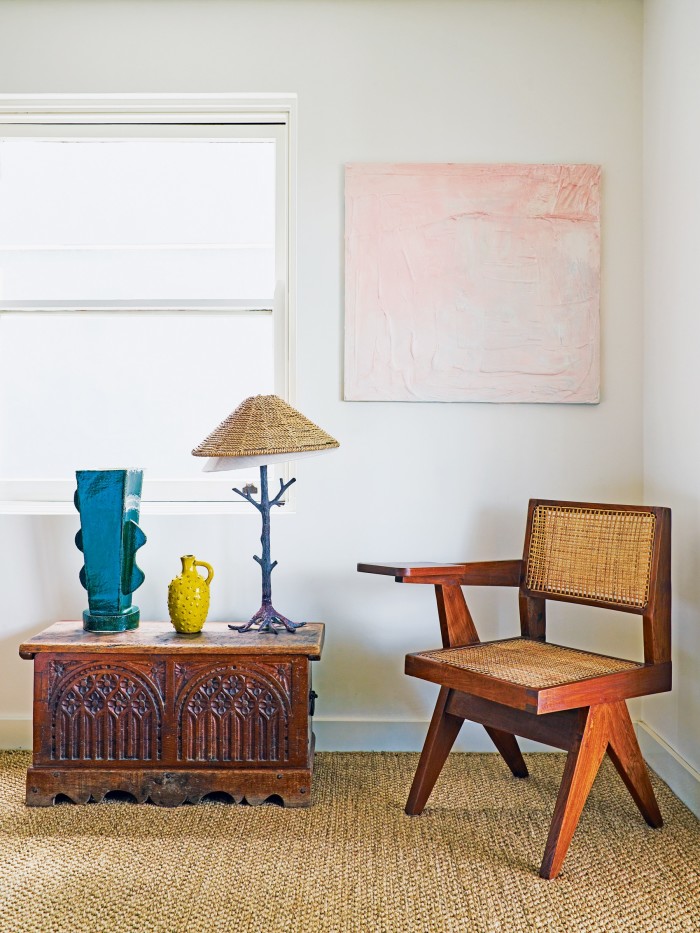
It manifests in the house above Tamarama Beach, a 1960s bungalow that the Johnsons acquired in late 2017, gutted and redesigned by Tamsin from the limed-plank floors up. It’s replete with important early-20th-century French and Danish furniture and antique Venetian glass, contemporary art and west African artefacts, its open kitchen anchored by a shiny black Aga, while a Calder-style mobile hangs on the terrace, spinning almost imperceptibly in the salty, opalescent air.
It’s equally visible in the far slicker and more colour-saturated P Johnson showrooms, particularly the one in Paddington, where a sunken conversation pit clad entirely in plush pink shag holds tasselled sofas and green-veined marble tables that Tamsin custom-designed for the space, and a two-metre-tall photograph of Gianni Agnelli, smouldering in a velvet tuxedo, hangs on one wall.
And it’s present in the P Johnson clothes themselves. There is no house silhouette per se, but slightly softer lapels and higher waists are showcased, and homage is paid both to the lightness of Italian construction and the fitting rituals (if not necessarily the strict protocols) of British haberdashery – alongside, on any given day, ready-to-wear displays of espadrilles, or swim trunks, or drawstring shorts. Or even baseball caps.
Because Australia. So why not? This is a subtext of the P Johnson message. “The thing is, we’re at the bottom of the world down here and we understand that,” says Patrick. “We understand that in a global sense we’re sort of the rubes. But on the other hand, Australia is so wide open creatively. If I were doing what I do in Italy, it would almost perforce be an Italian tailoring business; if it were London, I’d have to conform somehow to Savile Row. Being down here frees us up to take the best things we see around the world and reinterpret them. There aren’t really any rules.”
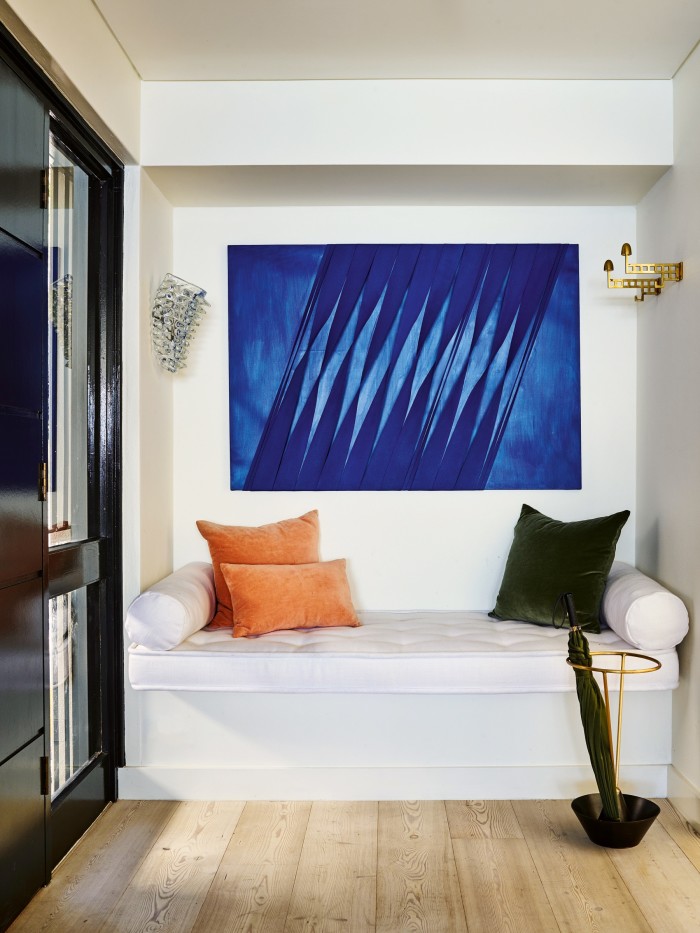
“That classical formation was really important for both of us,” says Tamsin, whose own polished personal style – glossy brown hair often pulled straight back, her closet full of The Row and Phoebe Philo-era Celine, delicate jewellery (much of it designed by her childhood friend Lucy Folk) – is sort of the anti-Bondi Beach: “That learning to do things the old-school way, then making them relevant the way you want to now.” By which she does not necessarily mean contemporary, though contemporary is extremely comme il faut in mainstream Australian design circles. Johnson relevance is timelessness, whatever the era of the components: “You look at a space like the Dries [Van Noten] shop in Paris – that’s the intention. Fifty years from now, I want someone to walk into an interior I’ve created and say they love it.” But because we’re in Australia, relevance also means eschewing the governing rules and rigidity of European design traditions in favour of spaces, materials and moods that accommodate the way people actually live. “Seven months a year we’re at the beach basically every single day. A huge part of living here is the incredible nature – it sounds cheesy, but that thing about bringing the outdoors in is true. So nothing can be too precious inside” – even if a piece is, in fact, precious. “My style is layered, textured, always natural. Never contrived or too stitched up.”
The Johnsons aesthetic hasn’t been lost on the world beyond Australia’s borders – not least because both of them spend so much time out in that world. There are P Johnson ateliers in New York and on Rathbone Street in Fitzrovia; every few months Patrick flies to Los Angeles and sets up shop in a bungalow at the Chateau Marmont to attend to his West Coast-based clients (quite a few of whom have highly recognisable names), and also commutes to clients in Jakarta, Kuala Lumpur, Boston and Chicago. Tamsin is a regular at the fairs in the south of France and Italy, on a first-name basis with many of their denizens. Among her recently completed projects are a Monaco penthouse, a mews in Marylebone and a loft on West Broadway in Manhattan; she is currently working on a members’ club in Dubai, further residential projects in LA and Jakarta, and – cue the buzz in boho-surfing circles – a second outpost of Raes on Wategos, the boutique bolthole of international renown in Byron Bay (which she also recently redesigned), slated to open around the middle of next year on Bali.
After years of informally sourcing 20th-century furniture, fixtures and objets for clients and other designers, Tamsin opened a retail showroom last December in a terrace on William Street (which is to Sydney’s Paddington as Chiltern Street is to Marylebone, or Walton Street to South Kensington). “I needed an office space, and I saw [fashion designer] Collette Dinnigan’s old shop at No 33 was on the market; we bought the building from her.” She gutted the first two floors, setting up her signature white-neutral backdrop and lining the space with inventory: Giò Ponti mirrors, Daum and Murano glass vases, Audoux-Minet Rope chairs, a few 19th-century Spanish pieces. But also things with no provenance at all. “The more I design, the more I like the not knowing things,” she told me the first time we met, a few years ago. “I’m more and more interested in the thing I don’t recognise, that I haven’t seen before. Anyone can have an Edra lamp; obscurity is exciting.”
These days Tamsin works at a large desk in the open space, facing the street, with the door open to the public. “About half of what I bring in from buying trips is pre-sold, but the rest is basically there for the taking. There’s a really small pool of quality stuff available in this country – we don’t have anything like what LA does with its amazing shops, or the Pimlico Road or St-Germain – so lots of designers here buy from me.
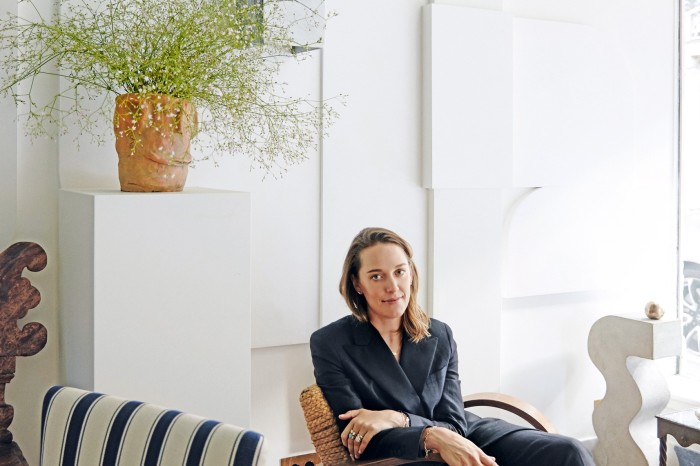
“That said, I want William Street to be really accessible,” she adds. “I say it’s open ‘by appointment or chance’. There’s not much of an antique dealers’ culture left in Australia, and in any case they were often quite intimidating places. I want the opposite here; I want everyone to feel welcome to come in and chat and maybe learn something about a designer or period.” And because not every piece in the inventory has certificate-calibre provenance, not all the prices are heart-stopping. “There are definitely more affordable things among the collectables,” she says. “Wall sconces I’ve designed, mixed in with the Pierre Jeanneret.”
William Street is also where, in August, the Johnsons hosted a champagne evening to launch PJ Femme, the much-anticipated P Johnson made-to-measure womenswear line that has been three years in the making. “It took some doing,” Patrick says with a laugh. “There’s not a whole lot of this kind of tailormade women’s stuff around. I developed the fits with a specific factory that I had pursued for a long time, because it’s not a small undertaking for them – they had to put all our technology in place – and most of the fabrics were developed from scratch as well,” says Patrick. “But it was worth it; it needed [that level of attention]. Clients need to be so secure in the comfort and elegance of what we make together that they just forget it once it’s on.”
Tamsin was along for the entire PJ Femme ride, unofficial adviser as well as muse. “It’s timeless and beautiful but also personal. They’re clothes that literally no one else will ever have, that will still be relevant” – that word again – “in months and years”. The collection launched with two jacket fits, each in double and single-breasted styles, two distinct trouser fits, dozens of exclusive-to-PJ Femme European and Japanese fabrics and as many trimmings. “Once you’ve been measured up, you can just call in and reorder, with this fabric, that cuff, this button, from anywhere in the world,” says Tamsin.
In November the Johnsons fly off again, to host the PJ Femme New York and LA trunk shows. They lived briefly in New York and both profess great affection for LA’s beaches and galleries, its pulse and energy. Could they see themselves living there too, one day? A unanimous and unequivocal “Yes”. And yet… “It would be hard,” says Patrick. “Life here is good, and there’s the beach…” Tamsin adds: “I know it sounds daunting getting on a plane for 14 or 24 hours, but it’s what we do so we can live here. And Sydney is home but it’s also a great base. It’s the one place we both want to live right now. The beauty, the nature, the beach…”
I’m waiting for it.
“…the lifestyle.”
P Johnson and PJ Femme, row.pjt.com. Tamsin Johnson, tamsinjohnson.com.
Comments